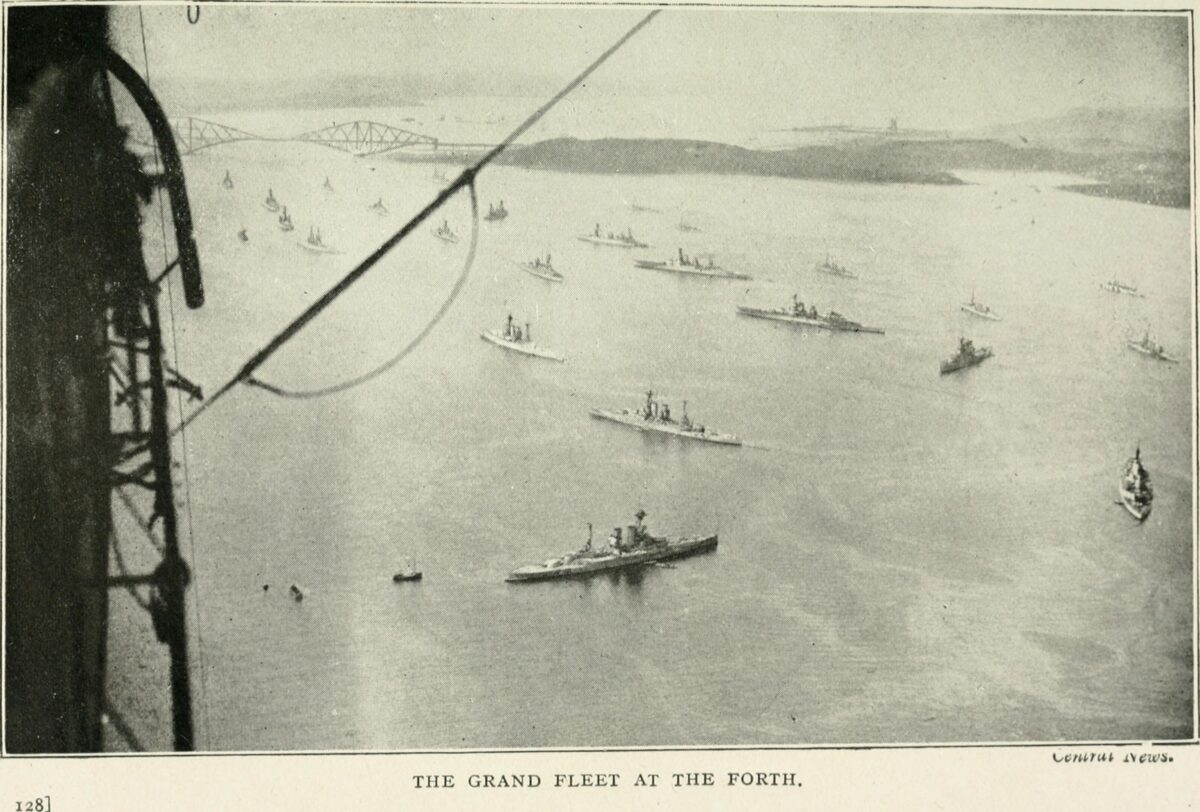Andrew Kerr treated us to a detailed and fascinating talk covering the range of naval actions in WW1 – those of the British Grand Fleet and the German High Seas Fleet (Hochseeflotte). Among the images he used were a number of very impressive works by marine artists showing the ships at sea and in action. Contemporary photographs further illustrated his talk.
- The British Ships.
The fleet consisted of around 160 ships which, in order of size and fire power, consisted principally of battleships, battlecruisers, cruisers and destroyers. In 1914 there were around 50 capital ships: 35 battleships and 15 battlecruisers. All that now remains of the capital ships which survived the war are the two 15 inch guns mounted at the entrance to the Imperial War Museum; one from HMS Resolution and one from HMS Ramillies.
Battleships armaments were typically 8×15″; 14x 6″ ; 2x anti-aircraft guns. They also carried 4 submerged torpedo tubes. The 15″ guns fired a shell weighing about 880 kg ( about the weight of a car) with a range of up to 18 miles. The firing rate could be 2 rounds per minute. About 30% of the ship’s weight was armour plating.
Battlecruisers had fewer guns and less armour (20% of their weight) which meant they were significantly faster than battleships. However, they were more vulnerable when caught in enemy fire.
2. The War at Sea
The Grand Fleet was initially based at Scapa Flow in the Orkneys, and in the Cromarty Firth but eventually moved south to the Forth. The German High Seas Fleet was based at Wilhelmshaven. In the first significant naval action in August 1914, a detachment of the British fleet attacked German warships in what was called the Battle of Heligoland Bight, where the German navy lost three light cruisers and had a number of other vessels severely damaged. Casualties and damage on the British side were relatively light.
In late 1914, elements of the German fleet bombarded Hartlepool, Scarborough and Whitby, causing significant damage and a considerable number of civilian casualties. Early in 1915 a squadron of the British fleet ambushed and chased a German flotilla, engaging them at long range. The armoured cruiser Blücher was sunk while the British battlecruiser Lion was badly damaged. The German navy learned an important lesson: to save a ship where fire threatened the magazines below the gun turrets – the threatened magazine was flooded. They then went about strengthening the armoured protection of the magazines on their ships before risking battle again. The British failed to learn this lesson.
The first and last naval action involving most of the Grand Fleet and most of the German High Seas Fleet took place 31 May/01 June 1916 – the Battle of Jutland. While it might be considered a tactical victory for the British because the German fleet never again left port until the war was over, it came at great cost. The losses on the British side greatly exceeded those of their opponents in ships and men. Three battlecruisers were lost, two of which blew up when shells penetrated their magazines. In all the British lost 14 ships and 6000 men, while the Germans lost 11 ships and 2500 men.
3. The Grand Fleet in the Forth
The battlecruiser group was the first part of the Grand Fleet to move into the Forth The ships were moored above the Forth Bridge toward Rosyth, and protected by the antisubmarine booms suspended from the bridge. When sufficient protection was in place seaward of the bridge – two sets of booms between the Lothian and Fife coasts, sufficient gun emplacements on the Forth islands – the battleships moved down from Scapa Flow. One can only imagine from this distance in time what a concentration of large warships occupied the area around the Forth Bridge. Getting in and out of the anchorage involved raising or lowering booms to let ships through, and when a squadron of battlecruisers was tasked to leave together this also involved very careful manoeuvring to avoid collision or running aground. That the anchorages were never penetrated by German ships or submarines is testament to the effectiveness of the Forth fortifications.
4. Surrender of the German High Seas Fleet
In November 1918 the cruiser HMS Cardiff left the Forth to rendezvous withe Grand Fleet 50 miles out in the North Sea. The German fleet there surrendered to the British and was then escorted, led by the Cardiff, to a temporary anchorage east of Inchkeith. The escort consisted of two lines of battleships and battlecruisers, 6 miles apart, one on each side of the German line. It included an number of French and US ships. In the Forth that day was gathered the largest concentration of warships ever seen. Within the week the German fleet raised anchor and was escorted to Scapa Flow, where it languished until June 1919 when the skeleton crews left on board carried out the secret order to scuttle. This was done to prevent the ships being appropriated by the navies of the allies. Some were left in situ and nowadays provide interesting locations for scuba divers, but the majority were raised over a number of years and scrapped.
Peter R
